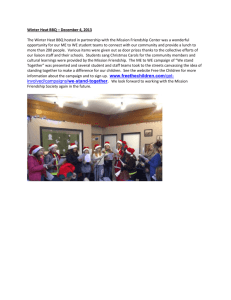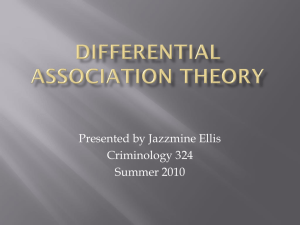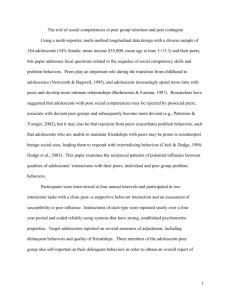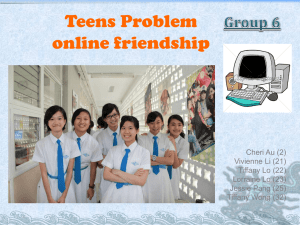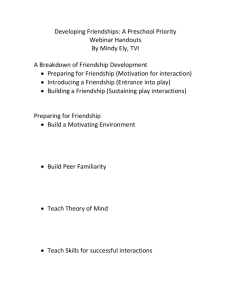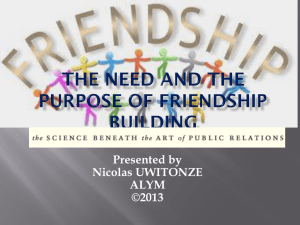Thesis Literature Review Skeleton
advertisement
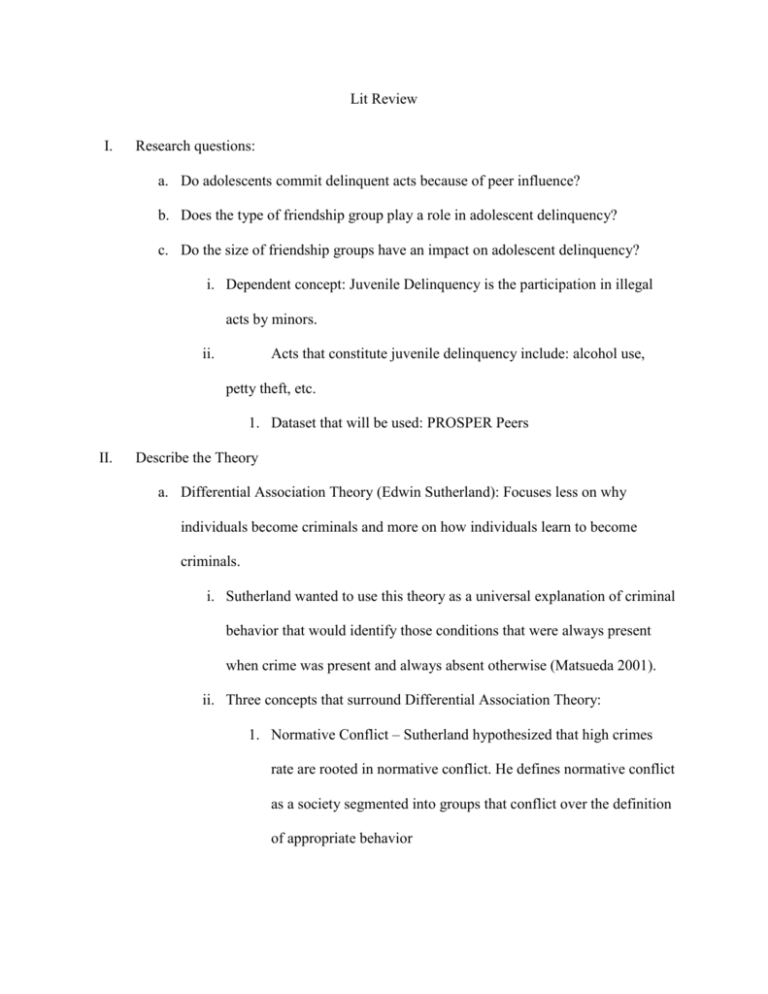
Lit Review I. Research questions: a. Do adolescents commit delinquent acts because of peer influence? b. Does the type of friendship group play a role in adolescent delinquency? c. Do the size of friendship groups have an impact on adolescent delinquency? i. Dependent concept: Juvenile Delinquency is the participation in illegal acts by minors. ii. Acts that constitute juvenile delinquency include: alcohol use, petty theft, etc. 1. Dataset that will be used: PROSPER Peers II. Describe the Theory a. Differential Association Theory (Edwin Sutherland): Focuses less on why individuals become criminals and more on how individuals learn to become criminals. i. Sutherland wanted to use this theory as a universal explanation of criminal behavior that would identify those conditions that were always present when crime was present and always absent otherwise (Matsueda 2001). ii. Three concepts that surround Differential Association Theory: 1. Normative Conflict – Sutherland hypothesized that high crimes rate are rooted in normative conflict. He defines normative conflict as a society segmented into groups that conflict over the definition of appropriate behavior 2. Differential Association – Criminal behavior is learned in a process of communication in intimate groups. 3. Differential Group Organization – The crime rate of a group or society is determined by the extent to which that group or society is organized against crime versus organized in favor of crime. iii. Focuses on the interactions and communication between adolescent individuals and explains that the learning of criminal behavior occurs within personal groups III. The size of a friendship group directly effects juvenile delinquency a. Previous research on this topic such as “Routine Activities and Individual Deviant Behavior” conducted by Osgood et al. proposes that situations conducive to deviance are prevalent in unstructured socializing activities especially when they occur in the absence of authority figures. i. In large friendship networks, there are more opportunities to partake in unstructured activities (i.e. drinking, drugs) because with more members there are more resources (i.e. locations to “hang out”). ii. Based on this and the article above, I hypothesize that due to an abundance of opportunities (in activities), adolescents who are part of larger friendship networks are more likely to be delinquent. b. Additional research that analyzes the size of friendship groups and its effect on juvenile delinquency is “Delinquency and the Structure of Adolescent Peer Groups” conducted by Derek A. Kreager, James Moody and Kelly Rulison. i. This study found that drinking seems to be positively associated with group cohesion. From this, one can assume that there may be associations between group cohesion and other delinquent acts, such as petty theft, as well. ii. Based on the above research, I hypothesize that due to a high level of trust (or group cohesion), adolescents who are part of smaller friendship networks are more likely to be delinquent. iii. Will indicate to readers that we do not intend for the above hypothesis to fit/relate with the one that states larger friendship groups are more likely to be delinquent. IV. The size of a friendship group effects the type of friendship group (close or not) which effects juvenile delinquency a. Previous research conducted on this topic suggests that peer influence plays a major role in the formation friendship networks and adolescents select friends who are similar to themselves. (Osgood et al.) i. In addition, previous literature also proposes that crime is a collective behavior and juvenile delinquency is no different (Marr, 58). ii. Based on this research, I hypothesize that friendship groups that are not close are less likely to be delinquent. V. Within peer networks, the delinquency of friends has an effect on juvenile delinquency a. Previous research completed on this topic resulted in mixed findings; however, in the study “Peers and the Emergence of Alcohol Use: Influence and Selection Processes in Adolescent Friendship Networks” Osgood et al. found a relatively strong influence. i. The evidence they found suggests that adolescents’ drinking has an important influence on their friends’ drinking. In addition, they found that individuals had a tendency to select friends who were similar to oneself (Osgood et al.). ii. Based on these conclusions that demonstrate the importance of peer influence within friendship networks, I hypothesize that adolescents who have friends that are delinquent are more likely to be delinquent. VI. Conclusion a. Research problem: What is the effect of friendship/peer networks on juvenile delinquency? b. Hypotheses: i. Adolescents who have friends that are delinquent are more likely to be delinquent ii. Due to a high level of trust, adolescents part of smaller friendship networks are more likely to be delinquent iii. Due to an abundance of opportunities (in activities), adolescents part of larger friendship networks are more likely to be delinquent iv. Friendship groups that are not close are less likely to be delinquent Bibliography Coleman, James S. The Adolescent Society; the Social Life of the Teenager and Its Impact on Education. New York: Free of Glencoe, 1961. Print. Crosnoe, Robert. Fitting In, Standing Out: Navigating the Social Challenges of High School to Get an Education. Cambridge: Cambridge UP, 2011. Print. Haynie, Dana L. "Reconsidering Peers and Delinquency: How Do Peers Matter?" Social Forces 84.2 (2005): 1109-130. JSTOR. Web. 17 Mar. 2014. Kreager, Derek A., Kelly Rulison, and James Moody. 2011, "Delinquency and the Structure of Adolescent Peer Groups", Criminology, 49: 95-127. Matsueda, R. L. "The Current State of Differential Association Theory." Crime & Delinquency 34.3 (1988): 277-306. Print. Osgood, Wayne, Daniel T. Ragan, Lacey Wallace, Scott D. Gest, Mark E. Feinburg, and James Moody. "Peers and the Emergence of Alcohol Use: Influence and Selection Processes in Adolescent Friendship Networks", Journal of Research on Adolescent Health, 501-12. Osgood, Wayne, Mark E. Feinburg, Scott D. Gest, James Moody, Daniel T. Ragan, Richard Spoth, Mark Greenberg, and Cleve Redmond. 2013, "Effects of PROSPER on the Influence Potential of Prosocial Versus Antisocial Youth in Adolescent Friendship Networks", Journal of Adolescent Health, 174-79. Osgood, Wayne D., Janet K. Wilson, Patrick M. O’Malley, Jerald G. Bachman, and Lloyd D. Johnston. 1996, “Routine Activities and Individual Deviant Behavior”, American Sociological Review, 61: 635-655. Warr, Mark. Companions in Crime: The Social Aspects of Criminal Conduct. Cambridge, UK: Cambridge UP, 2002. Print.
